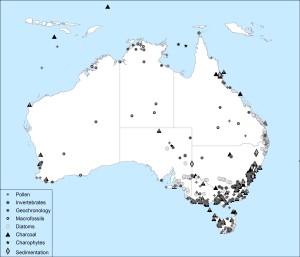Over the years there have been a number of collaborative projects undertaken by AQUA members. Below is a list of some of these projects.
-
- CLIMANZ – Climate Change in Australia and New Zealand
- OZPACS
- AUS-INTIMATE (Australasian INTegration of Ice Marine and TErrestrial)
- SHAPE (Southern Hemisphere Assessment of Paleo-Environments)
CLIMANZ was initiated in 1980 to bring the Quaternary researchers from Australia and New Zealand together, with climatologists. The aim was to piece together the physical record of Pleistocene climatic change and the processes that control it in this part of the Southern Hemisphere. A series of workshops were held in Australia and New Zealand. For more information see the CLIMANZ page and the data page.
The OZPACS project is a working group which aims to improve understanding of the human impact on Australian ecosystems over the last 500 years. OZPACS was deliberately envisaged as a project relating to short-time scales. It was funded through the ARC-funded ‘Environmental Futures Network’ (EFN) (http://www.adelaide.edu.au/efn/), and is the Australian contribution to the PAGES Focus 5 project (http://www.liv.ac.uk/geography/PAGESFocus5/aboutF5.htm).
All OZPACS sites
For further information see the OZPACS page to access the database, including metadata, bibliographies and GIS.
Australasian-INTIMATE 2003-2011
INTIMATE (INTegration of Ice-core, Marine and TErrestrial records was a core programme of the INQUA (International Union for Quaternary Research) Palaeoclimate Commission (PALCOMM)). The purpose of INTIMATE is to gain a better understanding of ‘geologically recent’ climate changes, particularly during the Last Ice Age (Glaciation) and the world-wide transition from ice age climates to the present ‘interglacial’ climate.
The INTIMATE project began in 1995 and has been carried out within particular geographic regions via meetings, conferences and resulting publications involving researchers in climate science. In 2003, an Australasian project (AUS-INTIMATE) commenced, with formal recognition from INQUA (Project Number 0806), and comprising two centres of activity, one in Australia (OZ-INTIMATE) and one in New Zealand (NZ-INTIMATE).
The focus of the Australasian INTIMATE project is to attempt to integrate Antarctic ice cores and the marine and terrestrial records for Australia and New Zealand. The aim is to develop a detailed chronologic picture of climatic changes and environmental consequences for the Australasian region over the past 30,000 years. This Southern Hemisphere perspective is a fundamental step in developing a detailed global understanding of the effects of past climate changes, and its implications for the future.
For more information and a list of all meetings and outcomes see the AUS-INTIMATE page.
SHAPE follows on from the AUS-INTIMATE initiative, which ran for two successive INQUA inter-congress periods from 2003 to 2011. This new project will start in 2013 and continue until next INQUA meeting in Japan in 2015. SHAPE will continue some of the goals of AUS-INTIMATE such as the production of high resolution paleoclimate records during the late Quaternary. However, it will have a wider spatial scope, incorporating New Zealand, Australia, the Pacific Islands, South America, South Africa, Antarctica and the Southern Ocean.
SHAPE sits under, and will provide information on the Southern Hemisphere to the INQUA International Focus Group CELL-50K (Calibrating Environmental Leads and Lags over the last 50ka) and ACER (Abrupt Climate Changes and Environmental Responses). Thus the time scale of focus has also extended back to 50-60 ka (the limit of radiocarbon dating).
Expertise and assembly of proxy data for different Southern Hemisphere sub-regions will be underpinned by existing and new INTIMATE ‘groups’. The work within each Southern Hemisphere sub-region will be coordinated by steering committee members, who will also be responsible for the exchange of information during hemisphere-wide integrations.
For more information and to find out how to get involved see the SHAPE page or contact the SHAPE coordinator Andrew Lorrey.

